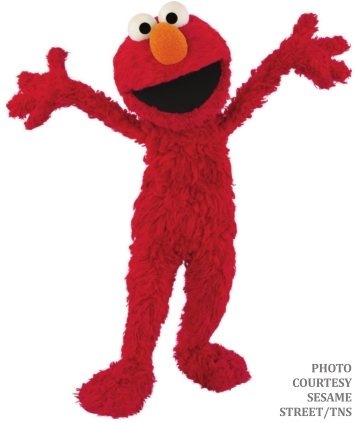

Your children can be like the ‘Girl who loved her feet!’
It’s funny how things have a way of coming full circle in life. During the early 70s, “Sesame Street” was a cornerstone of my childhood. Now, after of 4 ½ years of parenthood, the show still captures my attention and it helps me explain the world we live in. The creators of the show have proven that the combination of entertainment and learning can create an enjoyable and meaningful experience.
Although there are thousands of episodes and characters, I am sure everyone has their favorites. I am partial to episodes that deal with Elmo’s World on the Feet Channel, “the channel that keeps you on your toes.” My favorite episode is a “feet-ture” film of the “Girl Who Loved Her Feet!” In the opening scene, a young blond teenager climbs to the top of a little green hill in her bare feet and says, “I love my feet!” Then, she bends from the waist down and kisses her big toes. This girl does everything with her feet, and goes everywhere with them. She runs down hills, goes for long walks, plays at the beach, waddles in the mud, jumps rope and goes dancing. When she goes to bed at night, she even kisses her toes and her dog, Tootsie, licks them. OMG!
I hope that all young girls love their feet, maybe not in the same way as our Sesame Street character, but in a way that avoids embarrassment and fear of seeking medical attention. It is also my hope that the parents pay close attention to their children’s feet and seek medical attention if they recognize a problem. Here are some of the warning signs that you should look for:
• When your child starts to cover his/ her feet and does not expose them to you for fear of having to go to the doctor. This often happens if they feel pain or if there is a change in the appearance of their nails or feet, like toenail fungus, ingrown toenails or warts.
• When your child falls or trips more than usual. This may be a sign of a neuromuscular or balance problem, or an in-toeing problem.
• When your child is less willing to participate in a physical activity that he/she usually likes. This may be caused by heel pain or muscle strain or swelling in the back of the heel where the growth plate is located.
• When your child lags behind other playmates because his/her legs and feet are tired. Muscle fatigue can occur if your child’s feet do not function properly. Flat feet are a common cause.
• When your child tells you his feet or ankles hurt or complain of pain and soreness. Foot pain is never normal. Ingrown toenails and plantar warts are the most common problems for a child. Ingrown toenails usually occur because of improper nail cutting and if shoes are too tight or small. The child tries to tolerate the discomfort as long as he/she can; however, if the site becomes infected, seek medical attention. Simple in-of ice procedures can be performed to provide immediate relief and promote healing.
Plantar warts are usually caused by a virus and can develop anywhere on the foot. Over-the-counter medication can be used, but your podiatrist will have other more effective remedies – like acid treatment to the affected site or laser treatment – that will allow your child to return to normal activity immediately.
Other mechanical problems like in-toeing, out-toeing and toe walk, are easy to notice but should be addressed by your podiatrist to avoid future problems that could also have a negative effect on other body parts if left untreated. In many cases, custom orthotics can successfully treat these problems.
Athletic injuries like sprains, shin splints and fractures can be more serious and must be treated immediately to ensure that the ligaments heal properly in a stable position.
A more serious problem that can develop in the pre-teen years is Sever’s disease. This is a condition that causes pain in the back of the heel that is caused by tension on the growth plate of the heel. Growing children are more prone to stress fractures because the bones are immature and not fully developed.
Other problems that typically occur during adulthood that can also occur during childhood are plantar fasciitis, Achilles tendonitis and stress fractures. These conditions are fairly typical among youth who participate in rigorous sports like soccer, football, tennis and running, or activities like dance and cheerleading. The sooner you seek medical attention, the better it will be for recovery and a quick return to sport.
Other medical conditions like cerebral palsy, polio, club foot, multiple sclerosis, epidermolysis bullosa and muscular dystrophy may lead to foot deformities. Your podiatrist can recommend several shoe brands for children who have special foot care needs.
Sometimes a foot or ankle problem is not easy to detect in a child because they can’t articulate how they feel or what is bothering them. As a parent, it is important to inspect your children’s feet regularly and observe any of these warning signs.
Dr. John Sigle, founder of the Foot and Ankle Center of Illinois, has been providing advanced podiatric care in Springfield and central Illinois since 2004. Sigle specializes in all areas of foot and ankle care including ankle and foot fractures, heel pain, ingrown toenails, bunions, hammer toes, Achilles ruptures, foot deformities, pediatric foot care, diabetic ulcers, toenail fungus, arthritis, fusions, ankle revisions, total ankle replacement, and trauma.
